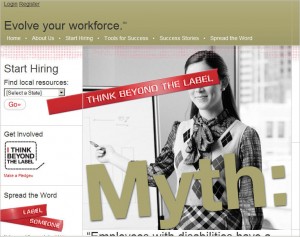A television ad has been running in the U.S. to promote disability/diversity awareness. Watch the spot online if you haven’t seen it—but basically, it’s a running (or actually, rolling) gag in which an African American woman in a wheelchair goes through the hallways of her workplace, commenting into the camera about the many types of “different” people in the office.
One of her co-workers is “Fashion Deficient,” another is “Copy Incapable,” and a third has “Volume Control Syndrome.” But, explains the narrator, no one in the office is concerned about labels (not even her own label, which turns out to be “Coffee-making Impaired”) because everyone is appreciated for their individual skills and contributions. A voiceover at the end says “Labels get in the way. Disabilities rarely do.” The viewer is invited to visit thinkbeyondthelabel.com, a website designed to educate decision-makers.
This ad is part of a $4 million campaign that will appear on television, in print, on the web and on billboards, according to the group Health and Disability Advocates (HDA). “The goal of the humorous, edgy campaign,” according to HDA, “ is to change attitudes about hiring people with disabilities, raising awareness of the need for diversity in the workplace, and countering stereotypes about people with disabilities.”
A New York Times story on the campaign explains that “the ads are being financed largely by agencies in 30 states that provide employment services as well as health and human services to their citizens who are disabled. The agencies have set a goal of raising $10 million for the campaign’s budget for the full year.” HDA spearheads this coalition, which has chosen to use a bold marketing approach rather than depending on Public Service Announcements to get their point across. According to the Times story, the campaign—which is targeted toward senior management, HR staff, and hiring managers—is intended to be “on that fine line of provocative but not polarizing.”
The campaign apparently tested well, and I haven’t found any information about response levels in the couple of months since it launched. I’m honestly not sure whether it’s a good idea or not. But I will say this: I really, really doubt that a “humorous” approach to disability/diversity would go down well on the corporate website, or in a board room, or—well, I just can’t think of a real workplace context in which this approach would seem acceptable.
And maybe that’s okay, since advertising is a special category of communication, with its own rules and goals. But on the other hand, maybe there can be too much of a disconnect . . .
Lucy is Editor at Corporate Eye
